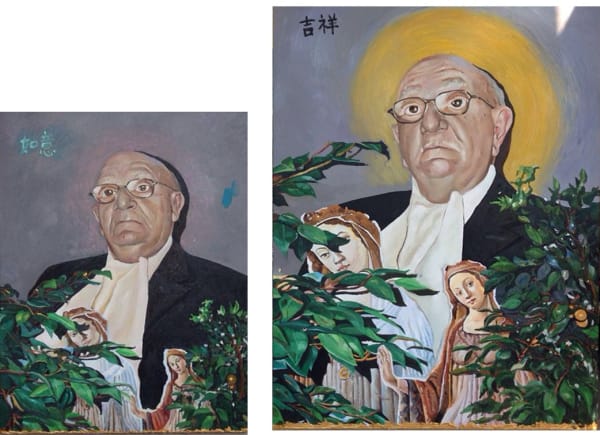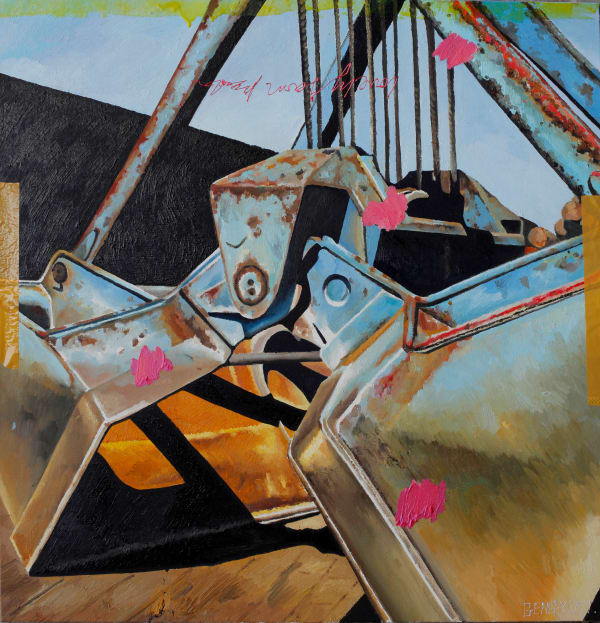Geng Yini: God Loves Whatever
“God loves whatever: be it drunkards, illiterates or the uneducated, grandparents, uncles or aunties, the conceited or the shameful, people with status or those without reputation ... they are everywhere and they are capable of anything. God loves them all!”
– Geng Yini
Intertwining her way through multiple mediums Geng Yini continues her bad-girl tactics in a new exhibi- tion that takes on the touchy subject of religion and faith. Her large-scale, expressive paintings juxtapose and overlay images from across the globe positioning the layman, in all their vulgarity, crude beauty, and misery, as God’s chosen ones. With a technique that is equal parts social-realism, graffiti, and ex- pressionism Geng’s surfaces and palate is alive with dirty splendor. Geng’s schizophrenic tableau and attitude continues in her installation and video works, which show her grandmother and friends reading, or mis-reading passages from the bible, eating fruit, and singing religious hymns.
Jesus died for somebody’s sins but not mine Meltin’ in a pot of thieves
Wild card up my sleeve
Thick heart of stone
My sins my own
They belong to me, me
- Patti Smith, Gloria
God and Jesus came to China for the first time in the 5th Century on the backs of grizzly Europe- an missionaries who preached their Lord’s word to the country’s puzzled peasants, staunch Bud- dhists, and very skeptical nobility. It wasn’t very popular at first. In fact it took several attempts over the next 15 centuries to finally take root, and when it did, it was quickly demonized as anti-sci- entific, imperialistic, and retarding the growth of a nation that was now in the throes of modernity. Soon after the communists saw Christianity as corrupting the minds of the masses - a capitalist opiate as it were, and they quickly squashed it out. God was certainly never as popular as Dao or Mao but today China miraculously boasts 30 million believers. God Bless them all!
What belief actually entails is beside the point- the best kind of faith is blind faith. It goes with- out saying that the Christian God is a radical de- parture from traditional Eastern philosophy. Not only is God a bearded, old white guy with lots of far-fetched stories to tell, but he’s also an an- tagonist who divides the spiritual from material, heaven from hell, and enlightened from layman. Chinese philosophy, on the other hand is caught up in meritocracy and the stuff of earthly beings: ethics and politics, morality and justice. There are no miracles, no virgin births, nor heavenly lust. In fact Christianity’s appeal to the masses of China may be its ability to inspire hope in a population that for so long was destined to a life of kowtowing and hard work with little payback. If there is no salvation- like the lofty fresh white sheets of heav- en- then what’s the point?
Geng Yini, inspired in part by her deeply devot- ed, slightly confused, and constantly proselytizing Grandma and in part by her own unsuccessful attempt to penetrate Christianity’s paradoxical messages about redemption proposes that God Loves Whatever. God’s love in fact is not just for priests’, popes, or monks, not even just for the believer, but indeed for the everyman and woman, who makes awful mistakes, smells rotten, wears out-of-date, over-sized clothes, and falls down drunk. God Bless the Laity with their bugger-sized brains, bad breath, and hangovers. These are the righteous ones, the chosen ones, ones that can’t give a damn. Geng’s sentiment is akin with Patty Smith’s who screams, “Jesus died for somebody’s sins but not mine”.
Geng Yini’s faithful Grandmother is presented here in a video where she reads, or misreads, in uni- son with a friend, passages from the bible. Here is the crux of Geng’s theme- a casual encounter with the faith of a senile, old lady. It is a show of com- passion, for her Grannie, herself, and country still caught up in cultural contradictions and a spiritual crisis. Geng’s exhibited works are less of a theo- logical critique than an emphatic feeling of being lost in something larger than oneself. It is also an excuse to make some art in the process of making sense of these feelings.
Auntie cooked dinner, but uncle is still worried about little brother’s schooling, 2014 is an extra large triptych of three seemingly disconnected images. Generous swathes of paint articulate two black and white figures on panels that straddle a candy colored image of birthday pastries. On the right a crouching older woman seems to be adjusting a Christmas tree, while on the far left a hairy ac- tor makes himself up as a sad clown. These three disparate images compose Geng’s diatribe on the pretenses of faith and its mundane reality. While there is the delicate promise of transcendence in a bite of birthday cake, or in Christmas time, or in the escapism of acting, there is also denial, dis- gust, and boredom. There are dishes to be done, crying babies to comfort, and makeup to wash off.
The pathetic but beautiful reality of being human also creeps up in We always feel sad for the grand holidays - a large diptych that shows an elderly woman sitting back with a towel over her eyes as if in a state of pain. On the right is a fat man in a top hat belting into a microphone. It seems as if her neighbor’s singing has caused the lady’s head- ache but they are of two distinct eras, and painted in different palettes. Yet both are slightly vulgar characters, marked by their over-enthusiasm on one side and over-exhaustion on the other. Neither is concerned about whether God is watching.
Geng’s pairing and choice of imagery is intuitive, improvisational, yet all of it is distinctly non-Chi- nese. Instead they originate, like Christianity, from the Western world of yesteryear. They may be from mid-twentieth century Europe or America, imbued as they are with a strange assurance of a better, more modern life. They may be even Russian. In fact today an endless source of imagery is at ev- eryone’s fingertips at all times. Geng scavenges pictures that, being so alien to her own experience attract her the most. It is a psychoanalytic strat- egy whereby the artist finds herself by displacing her ego onto a tableau of exotic imagery. With these pictures she then constructs an ongoing, non-linear, historical fantasy, played out over mul- tiple canvasses and installations. The result is an allegory, not unlike how the Holy Scriptures may read to an un-indoctrinated reader, peopled with a cast of regular, uncouth folk, somehow made fantastical.
Geng buries the specificity of this barrage of im- ages with graffiti scratches, thick impasto, and layering. Sometimes she’ll add some twigs, punch a hole in the work, or tie it up with a rope. She plays rough and never follows a rulebook or recipe. It is not very lady-like and not exactly Christian, but this is what gives Geng her edge – a feisty atti- tude, schizophrenic editing, and uncommon abili- ty to make materials sing the gospel.
Text / Mathieu Borysevicz
-
 Geng Yini 耿旖旎, Ore 矿石, 2014
Geng Yini 耿旖旎, Ore 矿石, 2014 -
 Geng Yini 耿旖旎, May God give us success in all our work 上帝保佑我们工作顺利, 2015
Geng Yini 耿旖旎, May God give us success in all our work 上帝保佑我们工作顺利, 2015 -
 Geng Yini 耿旖旎, Meet by chance with joy and peace- As you wish(left)Meet by chance with joy and peace - Joy(right)巧遇喜乐平安- 如意(左)|巧遇喜乐平安- 吉祥(右)巧遇喜乐平安- 如意(左)|巧遇喜乐平安- 吉祥(右), 2015
Geng Yini 耿旖旎, Meet by chance with joy and peace- As you wish(left)Meet by chance with joy and peace - Joy(right)巧遇喜乐平安- 如意(左)|巧遇喜乐平安- 吉祥(右)巧遇喜乐平安- 如意(左)|巧遇喜乐平安- 吉祥(右), 2015 -
 Geng Yini 耿旖旎, We always feel sad about the grand festivals 我们总是为节日的盛大而悲伤, 2015
Geng Yini 耿旖旎, We always feel sad about the grand festivals 我们总是为节日的盛大而悲伤, 2015











